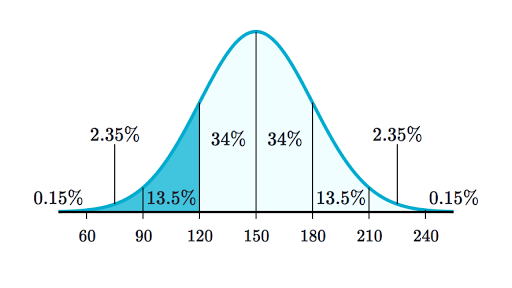Which of the Following Is True Regarding the Normal Distribution
The area under the normal curve is equal to 10. So a is true.
The Normal distribution sometimes it is also referred to as the ball-shaped distribution because the graph of its probability density functions resembles the shape of a bell.

. The curve stops at plus or minus 3 standard deviations. A Which of the following is true regarding the Central Limit Theorem CLT. Which of the following statements are true regarding the normal distribution curve.
Normal distributions are denser in the center and less dense in the tails. It is not ways symmetrical D. Which of the following is true regarding the normal distribution.
Around 68 of scores are between 1000 and 1300 1 standard deviation above and below the mean. The points of the curve touch the X-axis at z-3 and z3. 68of the area of a normal distribution is within one standard deviation of the mean.
The mean median and mode are all equal. A It is also called the z distribution. QUESTIONWhich of the following is NOT true regarding the normal distribution.
The area under the normal curve is equal to 10. ANSWERA Mean median and mode are all equalB It has a single peakC It is. C The mean is 0 and the standard deviation is 1.
The normal distribution is a probability distribution so the total area under the curve is always 1 or 100. The points of the curve meet the X - axis at Z - 3 and Z 3. 68of the area of a normal distribution is within one standard deviation of the mean.
Up to 25 cash back Which of the following is true regarding the normal distribution. B it is asymptotic in that each end approaches the horizontal axis but never reaches it. Which of the following are correct statements about a normal distribution.
Normal distributions are defined by two. Which of the following statements isare true regarding the normal distribution. All of the above are correct.
All of these statements are true. Normal distributions are denser in the center and less dense in the tails. All are true for a normal distribution.
B is also true as normal distribution is symmetrical. It is symmetrical distribution. It has one peak at the center of the distribution where Z 0.
Mean is not equal to the mode or the median. It can have more than a single peak. Which of the following is NOT true regarding the normal distribution.
Up to 25 cash back Which of the following is true in a normal distribution. Total area under the curve is equal to 1. All of these This problem has been solved.
Percentage of data within 1 standard deviation is 68 approx. For normal distribution I know that meanmodemedian. D All of the above are correct.
The area under the normal curve is equal to 10. IvThe mean median and mode of a normal distribution are equal. Which of the following is true regarding the normal distribution.
Which of the following statements is correct regarding the standard normal distribution. Mean median and mode are all equal C. Accrual basis accounting recognizes.
I v The mean median and mode of a normal distribution are equal. Following the empirical rule. C its mean median and mode are located at the same point.
Which of the following statements isare true regarding the normal distribution curve. Up to 20 cash back Which of the following is true regarding the normal distribution. All normal distributions have a variance of at least 1.
It cannot assume negative numbers. There is a 95 chance that values will be within 2 standard deviations of the mean. But to use it you only.
Mode equals the median. A Mean median and mode are all equal B It has a single peak C It is symmetrical D The points of the curve meet the X-axis at z -3 and z 3 E None of the choices are correct. The formula for the normal probability density function looks fairly complicated.
It can have more than one peak. The total area under the curve is greater than 1 B. B Any normal distribution can be converted to the standard normal distribution.
It is defined by its mean and standard deviation. It does not permit negative values. It is asymptotic in that each end approaches the horizontal axis but never reaches it.
а it is a symmetrical and bell-shaped curve. Its mean median and mode are located at the same position. Which of the following statements are true regarding the normal distribution curve.
Ii As the sample size n increases the data distribution should become approximately normal. The Normal distribution is symmetric unimodal and also asymptotic A normal distribution is perfectly symmetrical around its center. It has two.
Which of the following is true regarding the normal distribution. A normal distribution is also symmetric about its mean and thus 50 of the observations in a normal distribution are greater than the mean. It is always the appropriate distribution in simulation modeling.
Mean divides the distribution into two unequal parts. I If your sample size is n 30 exactly then you are guaranteed to have an approximately normal sampling distribution of the sample mean. 1289 students attemted this question.
See the answer Show transcribed image text. The total area under the curve is greater than 1 B. The property that does not hold for a normal probability distribution is then only two outcomes which is true as a normal probability distribution has infinitely many possible outcomes.

Normal Distributions Review Article Khan Academy


No comments for "Which of the Following Is True Regarding the Normal Distribution"
Post a Comment